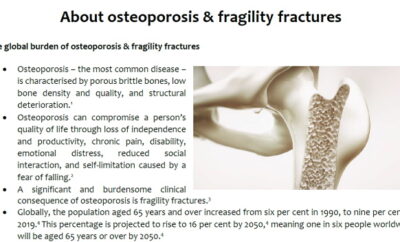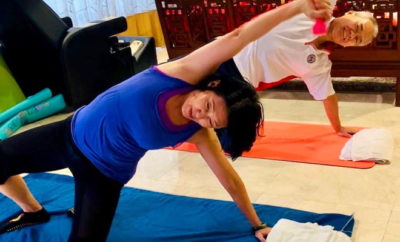
Health x Wellness
Osteoporosis in Women
Osteoporosis affects one in three women, and one in five men over the age of 50. It is a disease characterised by low bone density that can result in fracture-prone, brittle and fragile bones.
What is Osteoporosis?
“Osteoporosis”, Greek for “porous bone”, is a disease characterised by low bone density. Lower bone density can result in fracture-prone, brittle and fragile bones. This chronic disease affects one in three women and one in five men over the age of 50.
Individuals with osteoporosis are at higher risks of fractures which may occur even with minor stresses, like small falls, coughing, or even walking. This condition can have a significant negative physical and mental impact on one’s overall wellbeing and independence.
Who is at risk of developing osteoporosis?
Not many of us might know this, but bone development is not static. Our bodies are constantly breaking down old bone, and replacing it with new bone mass. When the rate of bone breakdown exceeds the rate of bone production, osteoporosis occurs. But what are the risk factors for developing this disease? Here are a few factors:
1) Age is a key risk factor for osteoporosis. Bone density increases all the way up to mid 20s, and most individuals will have built up their peak bone density by age 30. This remains stable up to about age 50, and begins to decline with advancing age.
2) Females are also at greater risk than males as their bones are both smaller, and less dense, when compared to males. Women also tend to lose bone mass more quickly after menopause due to decreased levels of estrogen.
3) A low BMI is also a risk factor.
4) Genetic factors like ethnicity (Asians and Caucasian women may be at greater risk) and a family history of osteoporosis may also increase one’s risk.
5) Medical conditions like hyperthyroidism, eating disorders, chronic kidney disease, or treatments including medications like oral corticosteroids, chemotherapy, may also increase your risk of developing osteoporosis.
6) Lifestyle factors such as living a sedentary lifestyle, smoking, alcohol ingestion, and low dietary calcium intake can all increase one’s risk of osteoporosis.
What are the signs and symptoms of osteoporosis?
The problem with detecting osteoporosis is its largely silent nature. Until fractures occur, most people do not know that they have it. While fractures can occur anywhere, the most common anatomical sites are the hip, wrist and spine. Other signs include a gradual loss of height over time, back pain and a stooped posture.

Hip fractures are most commonly caused by minor falls and can result in significant disability, loss of function and an increased risk of death within the first year after the fracture occurs. Some patients even suffer from multiple fractures, resulting in a severe deterioration in their quality of life.
What can women do to prevent osteoporosis?
Getting a head start in building bone density is the best way to prevent osteoporosis. Key to this is getting enough dietary calcium and vitamin D. While the RDA (recommended daily allowance) for calcium is 800mg for adults aged 19-50, the RDA for calcium is 1000mg for adolescents, adults above the age of 51 and pregnant or breastfeeding women.
Your body also needs vitamin D for bone health. Vitamin D is the most common form of vitamin deficiency globally, with studies showing between 15-60% of prevalence depending on the region, with a higher prevalence found in Caucasian and Asian women. Approximately 20-30 minutes of daily exposure to direct sunlight will allow your skin to make sufficient vitamin D, but this may come at the cost of UV skin damage, especially in equatorial countries such as Singapore. You should consider vitamin D supplementation if your vitamin D levels (as measured with a blood test) are low.
Staying active and exercising at least 30 minutes a day, several times a week, and engaging in weight bearing or resistance exercises are all helpful in maintaining and increasing bone density. Finally, it is important to avoid smoking and excessive alcohol ingestion.
What is the treatment for osteoporosis?
If you have osteoporosis, you may require medication to reduce further bone loss and to increase your bone mass. These may either come in oral form or as an injection. These are in addition to appropriate calcium and vitamin D intake and physical activity.
Early prevention is the best treatment for osteoporosis, so the earlier you begin to take steps to protect yourself from osteoporosis and to build and maintain healthy bones, the better.
Contributed by Dr Grace Huang. Dr. Huang is the resident doctor at DTAP Clinic, a general practice clinic with a special interest in Men’s, Women’s, and Sexual Health. She attained her Bachelor of Medicine and Bachelor of Surgery (MBBS) from the National University of Singapore and also holds the postgraduate qualification of the Membership of the Royal College of Physicians (MRCP UK).
She completed the Internal Medicine Residency Programme in one for the largest tertiary hospitals during which she also had the experience of working in a broad range of subspecialty departments across various tertiary hospitals, ranging from Neurology, Rheumatology, Endocrinology, Cardiology, Geriatrics Medicine to Emergency Medicine, amongst many others.
She has a keen interest in Women’s health and wellness medicine. She believes communication is the key to empowering patients through facilitating a better understanding of their own health and medical issues and is always more than glad to address and allay her patients’ concerns.
Photo by Mathew Schwartz on Unsplash









